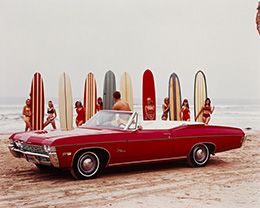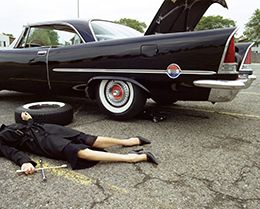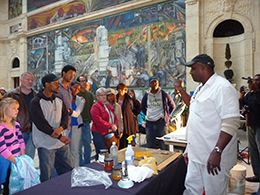|
|
 Director's Letter Director's Letter
The Fabergé exhibition closed with a bang on January 21, having drawn more than 85,000 visitors. It was gratifying to receive comments, both written and in person, expressing appreciation that we had taken a collection of expensive trinkets made mainly for an almost unimaginably privileged group of rulers and created a story about the intersection of art, people, and politics that threw light on the larger events of history. I was also tickled by a few comment cards whereby the DIA was scolded for using its exhibition shop to sell books and artifacts deriving from two of the most repugnant regimes in European history: those of the Russian tsars and the Union of Soviet Socialist Republics. What can I say?
I worked on a couple of exhibition projects between 1988 and 1992 in Moscow, and it is difficult to convey the overwhelming and pervasive sense of surveillance in the earlier visits. I bought no nestled dolls, nor army-surplus hats, though I was given a Lenin pin that I still have somewhere. Most of all, I remember the warmth and passion of the artists whose studios I visited with long Vodka-facilitated discussions going on into the wee hours. Some artists were openly dissident, and the fact that we were allowed access to them was a powerful sign of the times. Others were "official" painters and sculptors, sanctioned by the relevant Artists' Unions. A third group was made up of official graphic designers, who were able to use their access to studio space and artists' materials to pursue their personal ambitions as painters or sculptors. On one occasion, a colleague and I were visiting a married couple who fell into the last category. I was wielding a Polaroid camera (a show-stopping device in the USSR at that time), my colleague, a fancy Nikon. When they both malfunctioned simultaneously, I said to our interpreter, "I'm sorry both of our cameras have problems." Without missing a beat, one of the artists said (in English), "We have no such problems in the Soviet Union." (Younger readers of this newsletter may need to be told that the phrase used by the artist was a standard riposte by Soviet officials to issues raised by Western protagonists.)
Shirin Neshat, the artist whose retrospective exhibition the DIA will premiere in April, hails from a country similarly mired in repression. In this case, the situation is now, not a historical period safely in the past where contemporary attitudes are somehow shielded by the distance of time. We embarked upon the Neshat retrospective five years ago, long before the "Arab Spring" or the even earlier Green Movement spawned by the abuses of the Iranian government. Unlike Fabergé, our sympathies very much lie with the artist's social and political ideas and feelings: the desire for openness, tolerance, and equality. But--just like Fabergé--we are presenting this exhibition not because we agree with the artist's politics, but because we believe she gives her ideas form in a way that is very special in terms of artistic achievement.

Graham W. J. Beal
Back to top |
|

New on View
 Van Gogh's Bedroom in Arles Van Gogh's Bedroom in Arles
Through May 28, 2013
Dutch Galleries
Vincent van Gogh's Bedroom in Arles, a rarely loaned painting from the Musée d'Orsay in Paris, goes on view February 19 in the DIA's third-floor Dutch galleries, where the National Gallery of Art's Vermeer was seen last August. Three of the museum's works by Van Gogh--The Diggers, Portrait of the Postman Roulin, and his 1887 Self-Portrait--are also in the space. Bedroom in Arles remains in Detroit through May 28.
Van Gogh produced three, almost identical paintings of his bedroom. The first, in the Van Gogh Museum in Amsterdam, was created in October 1888. Almost a year later, Van Gogh made two more copies: one now in the Art Institute of Chicago and this one, originally made for the artist's family in Holland.
In a letter to his brother Theo, Van Gogh explained he was inspired to paint such a picture as a means of expressing the tranquility and simplicity of his bedroom using the symbolism of colors. He wrote, "I wanted to express absolute repose with these different colors," mentioning "the pale, lilac walls, the uneven, faded red of the floor, the chrome-yellow chairs and bed, the pillows and sheet in very pale lime green, the blood-red blanket, the orange-colored wash stand, the blue wash basin, and the green window."
Above: Vincent van Gogh, Dutch; The Bedroom at Arles, 1889; oil on canvas. Musée d'Orsay, Paris. Photo: Hervé Lewandowski. © RMN-Grand Palais/Art Resource, NY
Supported by Talmer Bank and Trust

Back to top Back to top |
|
Exhibitions
 Motor City Muse Motor City Muse
Detroit Photographs, Then and Now
Through June 16
Albert and Peggy de Salle Gallery of Photography
 | | |
Vern Hammarlund, American; 1968 Chevrolet Impala, ca. 1968 (printed 1996); chromogenic print. Collection of the Detroit Institute of Arts
| |  | | |
Nicola Kuperus, American; Flat, 2006, pigment print. Museum Purchase, Albert and Peggy de Salle Charitable Trust ©Nicola Kuperus, 2012
| |
Automotive photography experienced its golden age form about 1947 to the 1990s, playing a critical role in the mythology of cars being not just transportation but a part of the American dream. The genre is often overlooked in the history of photography, as fine art practice has dominated the field. But in Detroit, "car-shooters" were a dominant part of the photography scene. The work of several early innovators, including Walter Farynk, Vern Hammarlund, Mickey McGuire, Jimmy Northmore, and Warren Winstanley, are included in this exhibition.
These early automotive photographers pioneered compositional techniques and special effects that dramatized the look of a car by manipulating outdoor and studio lighting, enhancing the style, color, surface, and three-dimensionality of a vehicle. In addition, they crafted idealized scenarios that fed the consumer's love affair with the car, as typified in Hammerlund's shot of bathing suit-clad women with surfboards posed next to a bare-chested man sitting in a 1968 Chevrolet Impala convertible.
Out of this world of advertising, Detroit automobiles, and social constructs about women's roles in society come the staged photographs of Nicola Kuperus, who studied with and worked for automotive photographers. Influenced by the city's car culture and a love of vintage automobiles, she staged pictures of classic cars and well-dressed women in distress, as seen in Flat, a shot of a woman's torso and legs positioned next to a spare tire and a car with an open trunk.
An exhibition catalogue will be available in the Museum Shop later this month. Click here for information about a related lecture on February 1.
This exhibition has been organized by the Detroit Institute of Arts. Support has been provided by the Chrysler brand and Rock Ventures. Additional support has been provided by the City of Detroit.
 
Back to top
 Hidden Treasures Hidden Treasures
An Experiment
Through March 3, 2013
Walter Gibbs Learning Center in the Wayne and Joan Webber Education Wing
Check out this exhibition when it reopens February 5 to see what information visitors most wanted to see on labels for the eight works taken out of storage. The works initially went on view without explanatory labels beside them. But a few feet away were two stories about each work, and viewers were asked to choose those that were the most meaningful. Now that the votes are in, the exhibition closed for a day and has reopened featuring traditional labels with the winning stories.
This exhibition is organized by the Detroit Institute of Arts. Support has been provided by the National Endowment for the Arts and Walter Gibbs Endowment Fund. Additional support has been provided by the City of Detroit.

Back to top |
|
 Detroit Film Theatre Detroit Film Theatre
It's time for the perennial favorite, the Academy Award®-Nominated Short Films, running three weekends before the February 24 Oscar-award ceremony. The live-action and animated shorts are traditionally among the year's most creative and surprising films of any kind, yet they're also the most difficult to find. We'll present them in one eye-popping program, with a brief intermission between the animated and live-action categories.
This year, for the first time, we're presenting a program of all this year's Academy Award-nominated short documentary films. Feature-length documentaries have for the past several years enjoyed a higher profile than ever among moviegoers, but just as with the live-action and animated short film categories, short documentaries have been far more difficult to find in theaters.
The combined live-action and animated shorts program runs the weekends of February 1, 8, and 15. The documentary shorts play only once, on Thursday, February 21. Since some years tend to be more family friendly than others, check the DFT website for more details before bringing the kids. Even with the added shows, tickets are selling fast and advance ticket purchase is recommended.
For information about Black History Month films, click here. The entire DFT schedule is available here.
The DFT is presented by Buddy's Pizza.  Back to top |
|
 Black History Month Black History Month
Artist talks, lectures, films, music, and family events celebrating Black History Month fill the DIA schedule in February.
 | | |
Fred Wilson | |  | | |
Hubert Massey | |
Conceptual artist Fred Wilson, the 2013 Alain Locke International Award recipient for his contributions to the field of African American art, discusses his groundbreaking site-specific installations known as "museum interventions." He talks about his work, including his Murano glass chandelier, To Die Upon a Kiss, recently acquired by the DIA and on view in the second-floor contemporary art galleries.
 At the DFT, two directors present their films and discuss them after the screenings. On February 2, Julie Dash, the director of Daughters of the Dust, introduces the first of a series of films she selected. The Meaning of Hope, a new short film by Bill Gaskins, challenging the one-dimensional representations of Detroit, plays February 16 and is followed by a panel discussion moderated by Valerie J. Mercer, curator of the DIA's GM Center for African American Art, and featuring director, poet and playwright Bill Harris and DIA film curator Elliot Wilhelm. At the DFT, two directors present their films and discuss them after the screenings. On February 2, Julie Dash, the director of Daughters of the Dust, introduces the first of a series of films she selected. The Meaning of Hope, a new short film by Bill Gaskins, challenging the one-dimensional representations of Detroit, plays February 16 and is followed by a panel discussion moderated by Valerie J. Mercer, curator of the DIA's GM Center for African American Art, and featuring director, poet and playwright Bill Harris and DIA film curator Elliot Wilhelm.
In music, Joan Belgrave celebrates the work of jazz legend Dinah Washington, and Black Women Rock! presents a multimedia tribute to pioneer rocker Betty Davis.
Events especially for families include the puppet performance Can You Spell Harlem?, about a young boy's discovery of the artists from the Harlem Renaissance. Hubert Massey, one of the few African American painters working in the true buon fresco style, demonstrates his techniques.
For more information on these and other events, including dates and times, check the DIA website. Back to top |
|
 Newsmaker Newsmaker
Crain's Detroit Business has named DIA Director Graham Beal as one of ten individuals who made news in 2012 while leaving their mark on the business community in Southeast Michigan. He was singled out for the winning millage campaign that resulted in a ten-year, 0.2 mill dedicated levy in Wayne, Oakland, and Macomb Counties.
The millage is expected to generate about $23 million in annual revenue for the DIA, enabling direct fundraising efforts for an endowment campaign. Residents of the three counties receive free general admission to the museum. Back to top |
|
 Valentine's Day Valentine's Day
In the spirit of Valentine's Day, the DIA is offering Date Night: Clay Picture Frames in the art studio on Friday, February 15. Bring a date, friend, or spouse for an evening of hands-on art making, transforming clay into a picture frame for holding a photo, memento, painting, or drawing. For those ages 18 and older. Preregistration and prepayment required.
And if do-it-yourself isn't your style, check out the Museum Shop for gifts other than the usual candy or flowers. Choose from objects in all price categories--from heart-shaped spoons for $9 to a hand-crafted tile of lovebirds for $55. DIA members receive a 10 percent discount. Gifts can be ordered online at www.diashop.org.
Back to top |
|
|
|
|
|
Detroit Institute of Arts
5200 Woodward Avenue
Detroit, Michigan 48202
www.dia.org
313.833.7900
Comments or questions about the newsletter? Please contact us: comments@dia.org
ADMISSION
$8 adults, $6 seniors, $4 children
The museum is free for members and residents of Wayne, Oakland, and Macomb Counties
Contact the Membership HelpLine at
313.833.7971 or membership@dia.org
For group sales (15 or more) contact 313.833.1292 or dia.org/grouptours
|
HOURS
Museum
Mon CLOSED
Tue, Wed, Thur 9 a.m.-4 p.m.
Fri 9 a.m.-10 p.m.
Sat, Sun 10 a.m.-5 p.m.
PARKING
Valet parking is available at the Farnsworth entrance on Fridays, Saturdays, and Sundays, during regular museum hours. Beginning Tues., Dec. 4, valet parking is available all open hours. The price per car is $10.
Lighted, secure self-parking is available in the Cultural Center parking lot, between John R and Brush, behind the museum.
Ford Second Sundays are generously supported by the Ford Motor Company Fund. Next Ford Second Sunday, February 10.
|
CaféDIA
313.833.7966
Tue, Wed, Thur 11:30 a.m.-2:30 p.m.
Fri 11:30 a.m.-2:30 p.m., 5-9 p.m.
Sat, Sun 11:30 a.m.-3 p.m.
Kresge Court Coffee Stop
Tue, Wed, Thur 9 a.m.-3 p.m.
Fri-Sun 10 a.m.-4 p.m.
Museum Shop
313.833.7944 or museumshop@dia.org
Open during museum hours or online at diashop.org
|
|
|
|
|
|